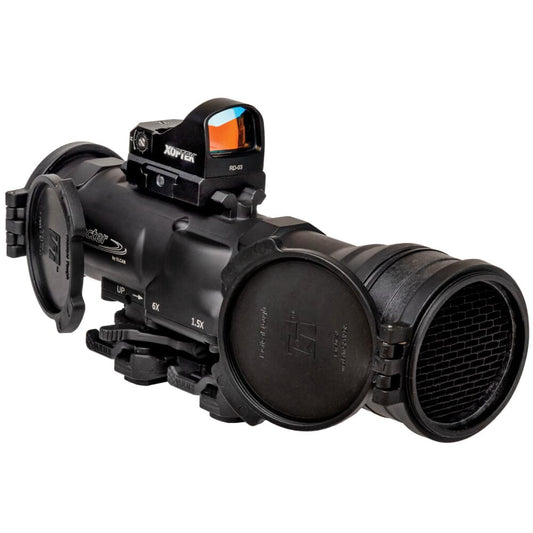

Elcan SpecterDR 1.5x/6x 5.56mm Riflescope offers a seamless transition between magnifications, allowing you to switch from 1.5x to 6x with a simple flip of the lever. This feature is ideal for both close-range engagements and distant targets, ensuring you’re ready for any shooting scenario. The integrated illumination system adjusts for varying light conditions, maintaining accuracy whether you're shooting in bright daylight or low-light settings.
With its exceptional field of view, the SpecterDR keeps you aware of your surroundings, a crucial advantage in tactical situations. The included XOPTEK Micro Reflex Sight enhances target acquisition at close range, providing a reliable backup when speed is essential. Built to withstand tough environments, this riflescope combines advanced performance with robust construction, making it a dependable choice for both competitive and tactical shooters.
Features:
- INSTANT MAGNIFICATION CHANGE: Unique throw-lever for quick transitions between 1.5x and 6x settings.
- ILLUMINATED RETICLE: Adjustable illumination enhances visibility in varying light conditions.
- OPTIMIZED EYE RELIEF: Consistent eye relief at both magnifications for comfortable shooting.
- GENEROUS FIELD OF VIEW: Maintains awareness of surroundings at both 1.5x and 6x for tactical advantages.
- DURABLE CONSTRUCTION: Rugged design ensures reliability in harsh environments.
- XOPTEK REFLEX SIGHT: Provides a reliable close-range aiming solution, enhancing versatility.
- PRECISE ADJUSTMENTS: 1/2 MOA turret adjustments for fine-tuning your aim.
- LIGHTWEIGHT DESIGN: Weighing only 1.57 lbs, it won’t slow you down on the field.
Technical Specifications Table
| Specification | Details |
|---|---|
| Magnification Range | 1.5x/6x |
| Exit Pupil | 7mm |
| Eye Relief | 70mm |
| Field of View | 86 ft @ 100 yds (1.5x), 21 ft @ 100 yds (6x) |
| Weight | 1.57 lbs |
| Scope Length | 7.2" |
| Reticle Position | First Focal Plane |
| Turret Adjustment | 1/2 MOA |
What’s in the Box?
- Elcan SpecterDR Riflescope
- Anti-Reflection Device (ARD)
- 3MOA XOPTEK Micro Reflex Sight
Customer Reviews
"This riflescope is a must-have for any serious shooter! The throw-lever is a game changer." - Jamie P.
"The optics are crystal clear, and the illumination feature is fantastic!" - Alex R.
FAQ
How does the SpecterDR perform in low light conditions? The illuminated reticle enhances visibility, allowing for precision shooting even in dim environments. Its design ensures optimal performance regardless of lighting.
How does the SpecterDR compare with other riflescopes? The unique throw-lever magnification change sets it apart, offering faster adaptability than traditional scopes. Its durable build and lightweight design also make it ideal for field use.
Similar Models
Looking for more exceptional optics? Explore our complete Elcan lineup, including models like the Elcan SpecterDR 1-4x and Elcan SpecterOS 1-8x for diverse shooting needs. Elevate your shooting setup today!
You May Also Like
Here’s some of our most similar products people are buying. Click to discover trending style.







